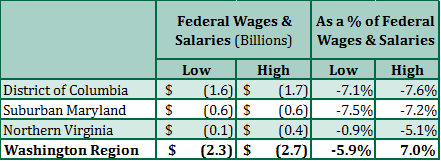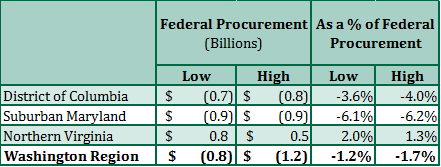The net direct effect of the Trump budget, if implemented as proposed, would result in
- a decrease of from 20,000 to 24,600 federal jobs, taking between $2.3 and $2.7 billion of federal salaries out of the economy,
- a decrease of from $800 million to $1.2 billion in federal procurement spending, resulting in a loss of up to 12,000 private sector contractor jobs, and
- a decrease of $1.1 billion in federal grants in the Washington region.
Overall, federal spending in the region would decrease between $4.2 and $5.0 billion, the equivalent of reducing region’s Gross Regional Product growth rate by about one percentage point.
These estimates assume that employment and procurement changes will occur proportionally to budget reductions by agency and are shown in the tables below based on the current location of the activity. However, it is likely that activity will shift, both within the region and the nation. Within the region, jobs may be consolidated into owned space, which is more concentrated in the District, or into longer-term, lower-cost leases. Similarly, jobs are likely to be consolidated into the main offices, largely located in the region, from other places in the US, unless there are directions to do otherwise.
Federal Employment
Given these assumptions, the region would lose between 20,000 and 24,600 federal jobs, or between 5.4 and 6.6 percent of all federal jobs in the region. The jobs are currently concentrated in the District, which is expected to lose between 7.0 and 7.4 percent of the federal job base. Throughout the region, the cuts to the Department of Health and Human Services will result in the largest losses (a decrease of 5,400-6,600 jobs), followed by losses from the State Department (3,500-4,300 jobs) and the Department of Commerce (2,800-3,400 jobs).

While the net effect on federal employment would be negative, not every agency is slated for cuts. Proposed budgetary increases for the Departments of Defense, Homeland Security and Veterans Affairs are allocated towards warfare readiness and military equipment, border security and enforcement, and improvements in Veteran patient care. The federal workforce in the Washington region performs relatively few of these functions, but may have modest gains in cyber security and infrastructure technology occupations in these agencies. These employment gains would be insufficient to offset employment losses from other agencies in the region.
Federal Wages and Salaries
The overall impact on federal wages and salaries is somewhat higher than the effect on federal employment because agencies with proposed cuts have somewhat higher average wages than those without or those with gains in our region. The estimated loss of between $2.3 and $2.7 billion is between 5.9 and 7.0 percent of all federal wages and salaries in our region.

Federal Procurement
Federal procurement is a significant driver in our region and would decrease by between $800 million and $1.2 billion based on the proposed Trump budget. Cuts to the Department of Health and Human Services are likely to have the largest negative effect on procurement spending in the region, with losses concentrated in Suburban Maryland. Decreases to State Department procurement spending are likely to account for the second largest decrease in the region and would be concentrated in the District. An increase in Department of Defense procurement spending seems likely, offsetting the declines in Northern Virginia and resulting in modest gains.

Federal Grants
The region could lose $1.1 billion in federal grants if the changes in the Trump budget are applied proportionally by agency. An 18 percent decrease to grants from the Department of Health and Human Services could result in a loss of about $370 million in the District, $55 million in Suburban Maryland and $21 million in Northern Virginian and could be the largest declines of any agency in the region.

The direct effect of the proposed Trump budget on federal activity in our region will have a noticeable effect on the region’s economy and could undermine growth in the upcoming years. As we learn more about the budget and its implementation, we will update these analyses.
About These Data
The employment and salary estimates are based on agency-level data from the Office of Personnel and Management (OPM) in March 2016 (FedScope Employment Cube, Raw Datasets) and the Current Employment Statistics from the Bureau of Labor Statistics (BLS). OPM releases state-level data that were re-weighted using BLS data to estimate year-end employment and salary numbers by sub-state area for the region. Jefferson, WV is excluded. Numbers may not sum due to rounding.
The procurement and grant estimates are based on agency-level data by place of performance from USAspending.gov (full datasets). The procurement estimates incorporate both FY2010 and FY2016 while the grant estimates are based on FY2016 data. Jefferson, WV is excluded. Numbers may not sum due to rounding.

This post has been updated to correct a typo.
